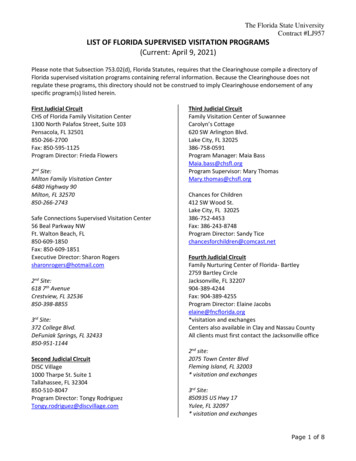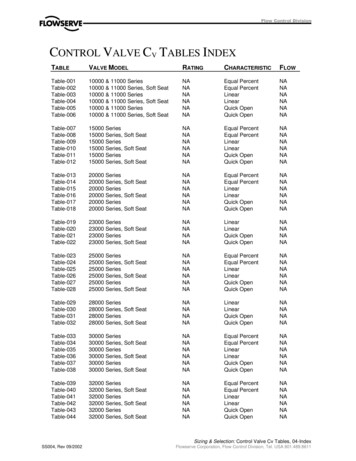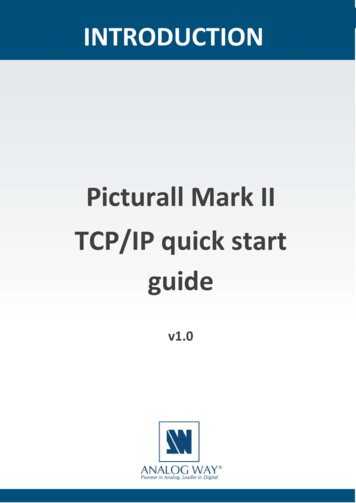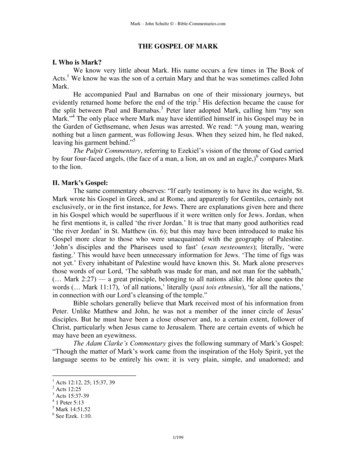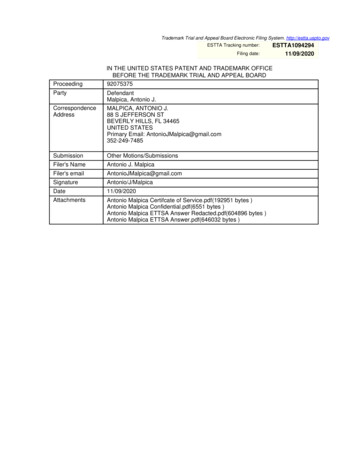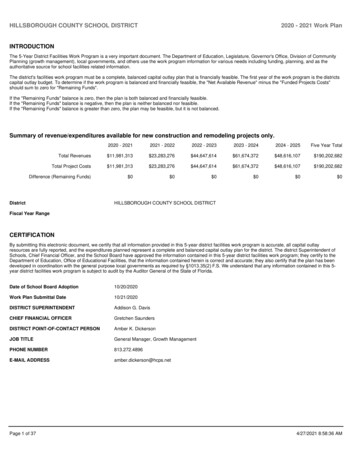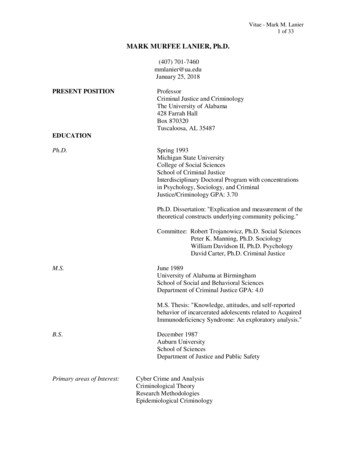
Transcription
Vitae - Mark M. Lanier1 of 33MARK MURFEE LANIER, Ph.D.(407) 701-7460mmlanier@ua.eduJanuary 25, 2018PRESENT POSITIONProfessorCriminal Justice and CriminologyThe University of Alabama428 Farrah HallBox 870320Tuscaloosa, AL 35487EDUCATIONPh.D.Spring 1993Michigan State UniversityCollege of Social SciencesSchool of Criminal JusticeInterdisciplinary Doctoral Program with concentrationsin Psychology, Sociology, and CriminalJustice/Criminology GPA: 3.70Ph.D. Dissertation: "Explication and measurement of thetheoretical constructs underlying community policing."Committee: Robert Trojanowicz, Ph.D. Social SciencesPeter K. Manning, Ph.D. SociologyWilliam Davidson II, Ph.D. PsychologyDavid Carter, Ph.D. Criminal JusticeM.S.June 1989University of Alabama at BirminghamSchool of Social and Behavioral SciencesDepartment of Criminal Justice GPA: 4.0M.S. Thesis: "Knowledge, attitudes, and self-reportedbehavior of incarcerated adolescents related to AcquiredImmunodeficiency Syndrome: An exploratory analysis."B.S.Primary areas of Interest:December 1987Auburn UniversitySchool of SciencesDepartment of Justice and Public SafetyCyber Crime and AnalysisCriminological TheoryResearch MethodologiesEpidemiological Criminology
Vitae - Mark M. Lanier2 of 33ACADEMIC POSITIONSSummer 2014 – Summer 2016 Associate Director Cyber InstituteOffice of the Vice President for ResearchUniversity of AlabamaFall 2013 – Summer 2014Assistant to the Dean for Special ProjectsFall 2010 – Fall 2016Full Member Graduate FacultyGraduate SchoolUniversity of AlabamaSummer 2010 – Fall 2013Professor and ChairpersonDepartment of Criminal JusticeUniversity of AlabamaFall 1998 – Spring 2010Associate Professor (tenured 1/98)Department of Criminal Justice & Legal StudiesUniversity of Central FloridaFall 1993 – Summer 1998Assistant ProfessorDepartment of Criminal Justice & Legal StudiesUniversity of Central FloridaFall 1992 - Summer 1993Assistant ProfessorDepartment of Sociology, Anthropology and CriminologyEastern Michigan UniversityWinter 1991Visiting LecturerDepartment of Sociology, Anthropology and CriminologyEastern Michigan UniversityFall 1991 - Summer 1992InstructorSchool of Criminal JusticeMichigan State University
Vitae - Mark M. Lanier3 of 33PUBLICATIONSBooks14). Lanier, Mark M. (2018, in preparation)From Papyrus to Cyber: The Evolution of American Justice (How Technology has DirectedJustice Practice and Policy) Oxford University Press, Oxford, England.13). Lanier, Mark M. and Lisa Briggs (2018)Research Methods in Crime, Justice and Social Problems: A Mixed Methods Approach, 2nd ed.Oxford University Press, Oxford, England.12). Anastasia, Desire’, Mark M. Lanier and Douglas Klutz (editors) (2014). Crime, Law &Justice. Cognella Academic Publishing, San Diego, CA. 276 pages.11). Lanier, Mark M. and Lisa Briggs (2014)Research Methods in Criminal Justice and Criminology: A Mixed Methods Approach, OxfordUniversity Press, Oxford, England. 316 pages.10). Seigfried-Spellar, Kathryn and Mark M. Lanier (editors) (2014)Essential Reading in Cybersecurity Theory and Policy, Cognella Academic Publishing, SanDiego, CA. 201 pages.9). Lanier, Mark M. and Edmund “Ted” Sexton (editors) (2014)Homeland Security: Preparation, Threats and Response, Cognella Academic Publishing, SanDiego, CA. 214 pages.8). Lanier, Mark M., Catherine Ford*, Jonathan Reid* and Katlyn Stricklend* (editors) (2014)Advanced Research Methods for the Social Sciences, Cognella Academic Publishing, San Diego,CA. 199 pages.7). Klutz, Douglas* and Mark M. Lanier (editors) (2013)From the Crime to the Courts: An Overview of Criminology and Criminal Justice, CognellaAcademic Publishing, San Diego, CA. 330 pages.6). Lanier, Mark M. and Stuart Henry (2010)Essential Criminology, 3rd ed., Westview/Perseus Press, New York, NY. 473 pages.5). Henry, Stuart and Mark M. Lanier (editors) (2006)The Essential Criminology Reader, Westview/Perseus Press, New York, NY. 381 pages.4). Lanier, Mark M. (editor) (2006)The Impact of HIV/AIDS on Criminology and Criminal Justice, The International Library ofCriminal Justice, Criminology and Penology. Ashgate Publishing, Hampshire, England. 359pages.3). Lanier, Mark M. and Stuart Henry (2004)Essential Criminology, 2nd ed., Westview/Perseus Press, New York, NY. 430 pages.
Vitae - Mark M. Lanier4 of 33Books (con’d)2). Henry, Stuart and Mark M. Lanier (editors) (2001)What is Crime: Controversies over the Nature of Crime and What to do about it, Rowman andLittlefield Publishers, New York, NY. 288 pages.1). Lanier, Mark M. and Stuart Henry (1998)Essential Criminology, Westview/Harper-Collins, Boulder, CO. 363 pages.Peer-reviewed Articles(* Students and former students, ** Authorship listed alphabetically, equal co-authors)34). Lanier, Mark M. (2018, under review).“Mixed Methods Research in Criminology.” Oxford Bibliographies, Oxford University Press,Oxford, England.33). Lanier, Mark M. and Amari Cooper* (2016)“From Papyrus to Cyber: The Evolution of Criminal Justice (How Technology has DirectedCriminal Justice Practice and Policy).” Special Invited issue of Criminal Justice Studies, 29, 2: 9104.32). Restivo, Emily* and Mark M. Lanier (2014)"The Impact of Extra-Legal Factors on the Labeling of Juveniles as 'Offenders'." ActaCriminologica, 27, 30-46.31). Lanier, Mark M. and Colin Farrell (2014)“A Mixed Methods Analysis of Human Trafficking.” Journal of Social Sciences Research, III:66-95.30). Lanier, Mark M., Barbara Zaitzow and Colin Farrell (2015)“Epidemiological Criminology: Contextualization of HIV/AIDS Health Care for FemaleInmates.” Journal of Correctional Health Care, 21, 2, 152-163 (Special Issue)29). Lanier, Mark M., Colin Farrell and Christiaan Bezuidenhout (2014)“A Comparative Analysis of Human Trafficking Between the United States of America (USA)and the Republic of South Africa (RSA).” International Journal of Criminology and Sociology, 3,275-283.28). Restivo, Emily* and Mark M. Lanier (2013)“Measuring the Contextual Effects and Mitigating Factors of Labeling Theory.” JusticeQuarterly, 1-26. http://dx.doi.org/10.1080/07418825.2012.75611627). Polizzi, David and Mark M. Lanier (2013)“Crime as Dis-ease: Towards an Epidemiological Criminology of the Social Body.” ActaCriminologica: the South African Journal of Criminology, 25, 2, 37-49.26). Chowdhury, Ishita* and Mark M. Lanier (2012)“Rape and HIV as Methods of Waging War: Epidemiological Criminology’s Response.”Advances in Applied Sociology, 2, 1, 47-52.
Vitae - Mark M. Lanier5 of 33Peer-reviewed articles, continued25). Martin, Nicole* and Mark M. Lanier (2011)“A Critical Review of American Law on Human Trafficking.” Alabama Academy of ScienceJournal, 82, 1, 26-43.24). Lanier, Mark M. (2010)“Epidemiological Criminology (EpiCrim): Definition and Application.” Journal of Philosophicaland Theoretical Criminology, 2, 1, 63-103.23). Lanier, Mark M., Robert P. Pack* and Timothy Akers (2010)“Epidemiological Criminology: Drug Use among African American Gang Members.” Journal ofCorrectional Health Care, 16, 1, 6-16.22). Lanier, Mark M. (2009)“Epidemiological Criminology: A Critical Cross Cultural Analysis of HIV/AIDS.” ActaCriminologica, 22, 2, 60-73.21). Akers, Timothy and Mark Lanier** (2009)“’Epidemiological Criminology’: Coming Full Circle.” American Journal of Public Health, 99, 3,397-402.20). Lanier, Mark M. and Stuart Henry (2007)“Theories of the Definition of Crime.” Encyclopedia of Law and Society: American and GlobalPerspectives, 1, 331-336. Sage: Thousand Oaks, CA.19). Lanier, Mark M. (2006)“Academic Integrity and Distance Learning.” Journal of Criminal Justice Education, 17, 2, 244265.18). Lanier, Mark M. and Eugene Paoline III (2005)“Expressed Needs and Behavioral Risk Factors of HIV Positive Inmates.” International Journal ofOffender Therapy and Comparative Criminology, 49, 5, 561-573.17). Lanier, Mark M. (2002)“A Pedagogical Aid for Linking Methodological and Statistical Courses.” Journal of CriminalJustice Education, 13, 1, 155-171.16). Manning, Roy*, Mark Lanier and Cloud Miller (2001)“Encouraging Equitable Verdicts? The Impact of the Allen Charge on Jury Trial Deliberations.”The Journal of Public Affairs, 5, 7-23. Lead Article.15). Lanier, Mark M. and Cloud Miller (2000)“The Allen Charge: Expedient Justice or Coercion?” American Journal of Criminal Justice, 25,1, 30-40.14). Sloan, John J., Mark M. Lanier and Deborah DeBeers* (2000)“Policing the Contemporary University Campus: Challenging Traditional OrganizationalModels.” Journal of Security Administration, 23, 1, 1-20.
Vitae - Mark M. Lanier6 of 33Peer-reviewed articles, continued13). Lanier, Mark M., Robert P. Pack* and Ralph DiClemente (1999)“Changes in Incarcerated Adolescents Human Immunodeficiency Virus (HIV) Knowledge andSelected Behaviors from 1988 to 1996.” Journal of Adolescent Health, 25, 3, 182-186.12). Henry, Stuart and Mark Lanier** (1998)“The Prism of Crime: Arguments for an Integrated Definition of Crime.” Justice Quarterly, 15, 4,609-627.12). Reprinted in John Muncie (ed). (2005) Criminology. Panchsheel Enclave, NewDelhi: Sage Publications.11). Lanier, Mark M. (1996)"An Evolutionary Typology of Women Police Officers." Women and Criminal Justice, 8, 2, 3557.10). Lanier, Mark M. and Scott Gates (1996)"An Empirical Assessment of the AIDS Risk Reduction Model (ARRM) Employing OrderedProbit Analysis." Journal of Criminal Justice, 24, 6, 537-547.9). Lanier, Mark M. and John Sloan (1996)"Cynicism, Fear, Communication and Knowledge of Acquired Immunodeficiency Syndrome(AIDS) among Juvenile Delinquents." Crime and Delinquency, 42, 2, 231-243.8). Lanier, Mark M. and Cloud Miller (1995)"Attitudes and Practices of Federal Probation Officers toward Pre-Plea/Trial Investigative ReportPolicy." Crime and Delinquency, 41, 3, 364-377.7). Barthlow, D., Patricia Horan, Ralph DiClemente and Mark Lanier (1995)"Correlates of Condom Use among Incarcerated Adolescents in a Rural State." Criminal Justiceand Behavior, 22, 3, 295-306.6). Lanier, Mark M. and William Davidson II (1994)"Methodological Issues Related to Instrument Development for Community PolicingAssessments." Police Studies, 17, 4, 21-40.5). Lanier, Mark M. and David L. Carter (1993)"Applying Computer Simulation to Forecast Homicide Rates." Journal of Criminal Justice, 21, 5,467-479.4). Lanier, Mark M., Ralph J. DiClemente and Pat F. Horan (1991)"HIV Knowledge and Behaviors of Incarcerated Youth: A Comparison of High and Low RiskLocales." Journal of Criminal Justice, 19, 3, 257-262.3). DiClemente, Ralph J., Mark Lanier, Pat F. Horan and Mark Lodico* (1991)"Comparison of AIDS Knowledge, Attitudes and Behaviors among Incarcerated Adolescents anda Public School Sample in San Francisco." The American Journal of Public Health, 81, 5, 628630.
Vitae - Mark M. Lanier7 of 33Peer-reviewed articles, continued2). Lanier, Mark M. and Belinda R. McCarthy (1989)"Knowledge and Concern about AIDS among Incarcerated Juvenile Offenders." The PrisonJournal, LXVIX, 1, 39-52, Spring-Summer.1). Lanier, Mark M. and Belinda R. McCarthy (1989)"AIDS Awareness and the Impact of AIDS Education in Juvenile Corrections." Criminal Justiceand Behavior, 16, 4, 395-411, December.(* Students and former students, ** Authorship listed alphabetically, equal co-authors)Book Chapters49). Marc M. Lanier -Stuart Henry, prisma del crimine, in C. Rinaldi- P. Saitta (eds.), Devianze ecrimine. Antologia ragionata di teorie classiche e contemporanee, PM, Varazze, 2017, pp. 503510.48). Lanier, Mark M. and Colin Farrell (2014)“Epidemiology of Crime and Deviance.” Encyclopedia of Social Deviance, C.J. Forsyth and H.Copes (editors). Sage Publications. Pp. 251-253.47). Lanier, Mark M. and Amanda Kate Shields (2014)“Taking it Back: Criminological Founders Meet Cyber Crime.” Essential Reading inCybersecurity Theory and Policy, Kathryn Seigfried-Spellar and Mark M. Lanier (editors).Cognella Academic Publishing, San Diego, CA. pp. 117-128.46). Lanier, Mark M., Stuart Henry, R. Ally Martin* and Parker Murff* (2014, in press)“The Crime Prism: The Challenge of Locating Contemporary Crime.” D come devianza. CirusRinaldi (editor). Liguori: Naples, Italy.45). Lanier, Mark M. and Stuart Henry (2014, in press)“The Crime Prism’s Cyber Dimension.” Seigfried-Spellar, Kathryn and Mark M. Lanier (editors)(2014, in progress) Essential Reading in Cybersecurity Theory and Policy, Cognella AcademicPublishing, San Diego, CA.44). Gordon, Kristie K.* and Mark M. Lanier (2014)“Culture: Conflict, Representation, and Response.” Encyclopedia of Criminal Justice Ethics.Bruce Arrigio (editor). Sage Publications43). Lanier, Mark M. (2014, in press)“Harms of Reduction and Repression.” Encyclopedia of Criminal Justice Ethics. SagePublications. Bruce Arrigio (editor).42). Musick, Andy*; Eldon T. Ferguson* and Mark M. Lanier (2014)“Genesis, Overview and Mission of the Department of Homeland Security.” Homeland Security,Mark M. Lanier and Edmund Sexton (editors). Cognella Academic Publishing, San Diego, CA.pp. 3-22.
Vitae - Mark M. Lanier8 of 33Book Chapters, continued41). Stevens, Jennifer M.* and Mark M. Lanier (2014)“Department of Homeland Security: Summary and Cyber Needs.” Homeland Security, EdmundSexton and Mark M. Lanier (editors). Cognella Academic Publishing, San Diego, CA. pp. 205213.40). Lanier, Mark M. and Lisa Briggs (2014)“Why Research at All”? Advanced Research Methods for the Social Sciences. Mark Lanier,Catherine Ford*, Jonathan Reid* and Katlyn Sricklend* (editors). Cognella AcademicPublishing, San Diego, CA pp. 5-26. Reprint.39). Lanier, Mark M. and Lisa Briggs (2014)“Mixed Methods.” Advanced Research Methods for the Social Sciences. Mark Lanier, CatherineFord*, Jonathan Reid* and Katlyn Sricklend* (editors) Cognella Academic Publishing, SanDiego, CA. pp.147-160. Reprint.38). Klutz, Douglas* and Mark M. Lanier (2013)“Overview of Corrections in the United States.” From the Crime to the Courts: An Overview ofCriminology and Criminal Justice, Douglas Klutz* and Mark M. Lanier (editors). CognellaAcademic Publishing, San Diego, CA. pp. 229-233.37). Klutz, Douglas* and Mark M. Lanier (2013)“Overview of Courts and Judicial Process in the United States.” From the Crime to the Courts:An Overview of Criminology and Criminal Justice. Douglas Klutz* and Mark M. Lanier (editors).Cognella Academic Publishing, San Diego, CA. p. 141.36). Klutz, Douglas* and Mark M. Lanier (2013)“Overview of Policing and Law Enforcement in the United States.” From the Crime to theCourts: An Overview of Criminology and Criminal Justice, Douglas Klutz* and Mark M. Lanier(editors) Cognella Academic Publishing, San Diego, CA. pp. 85-88.35). Lanier, Mark M. and Stuart Henry (2013)“The Study of Crime, Criminals, and Victims in a Global Context.” From the Crime to theCourts: An Overview of Criminology and Criminal Justice, Cognella Academic Publishing, SanDiego, CA. Douglas Klutz* and Mark M. Lanier (editors), pp. 67-82.34). Klutz, Douglas* and Mark M. Lanier (2013)“Defining Criminology.” From the Crime to the Courts: An Overview of Criminology andCriminal Justice, Cognella Academic Publishing, San Diego, CA. Douglas Klutz* and Mark M.Lanier (editors), pp. 55-66.33). Klutz, Douglas* and Mark M. Lanier (2013)“White-Collar Crime.” From the Crime to the Courts: An Overview of Criminology and CriminalJustice, Cognella Academic Publishing, San Diego, CA. Douglas Klutz* and Mark M. Lanier(editors), pp. 37-51.
Vitae - Mark M. Lanier9 of 33Book Chapters, continued32). Klutz, Douglas* and Mark M. Lanier (2013)“What is Crime?” From the Crime to the Courts: An Overview of Criminology and CriminalJustice, Cognella Academic Publishing, San Diego, CA. Douglas Klutz* and Mark M. Lanier(editors), pp. 3-36.31). Lanier, Mark M., David Polizzi and Alexandra Wade* (2014)“Addressing the ’Inherent’ Philosophical and Operational Dichotomies of Corrections from anEpiCrim Approach.” The Routledge Handbook of International Crime and Justice Studies. BruceArrigio and Heather Bersot (editors). Routledge, pp. 565-584.30). Lanier, Mark M. and Colin Farrell (2013, in press)“Epidemiology of Crime and Deviance.” Encyclopedia of Social Deviance. Heath Copes andCraig Forsyth (editors). Sage Publications.29). Lutya, Thozama and Mark M. Lanier (2012)“An integrated theoretical framework to describe human trafficking of young women and girls forinvoluntary prostitution in South Africa.” Public Health - Social and Behavioral Health. JayMaddock (editor). InTech International Publishing, pp. 555-570.28). Zaitzow, Barbara and Mark M. Lanier (2011)“’Doing HIV/AIDS ‘Time’: Health Care Needs of Women Prisoners.” Chapter in It’s a Crime:Women and Justice. 5th ed. Roslyn Muraskin (editor). Prentice Hall Publishing, pp. 441-455.27). Lanier, Mark M. and Courtney Juergens* (2011)“Compulsory HIV Testing.” Chapter in the Encyclopedia of Victimology and Crime Prevention.Sage Publications, pp. 135-136.26). Lanier, Mark M., Karol Lucken and Timothy Akers (2010)“Further need for Epidemiological Criminology.” Chapter in Key Correctional Issues. 2nd ed.Roslyn Muraskin (editor). Prentice Hall Publishing, pp. 163-174.25). Lanier, Mark M. and Roberto Hugh Potter (2010)“The Current Status of Inmates Living with HIV/AIDS.” Chapter in Key Correctional Issues. 2nded. Roslyn Muraskin (editor). Prentice Hall Publishing, pp. 140-162.24). Lanier, Mark M. (2010)“The Potential for Delinquency among Victims of Human Trafficking.” Insert in EssentialCriminology. 3rd ed. Mark Lanier and Stuart Henry Westview/Perseus, pp. 200-202.23). Lanier, Mark M. (2010)“Mental Illness and Cracks in the System.” Insert in Essential Criminology. 3rd ed. Mark Lanierand Stuart Henry Westview/Perseus, pp. 138-140.22). Lanier, Mark M. and Roberto Hugh Potter (2009)“The Current Status of Inmates Living with HIV/AIDS.” Chapter in Chapter in Visions forChange: Crime and Justice in the Twenty-First Century. 5th ed. Roslyn Muraskin and Albert R.Roberts (editors). Prentice Hall Publishing, pp. 542-567.
Vitae - Mark M. Lanier10 of 33Book Chapters, continued21). Lanier, Mark M. and Kelly Jocklin* (2009)“Contemporary Policewomen: A Working Typology.” Chapter in Visions for Change: Crimeand Justice in the Twenty-First Century. 5th ed. Roslyn Muraskin and Albert R. Roberts(editors). Prentice Hall Publishing, pp. 314-327.20). Sloan, John J. and Mark M. Lanier (2007)“Community Policing on University Campuses: Tradition, Practices and Outlook.” Chapter inCampus Crime: Legal, Social, and Policy Perspectives. 2nd ed. Bonnie S. Fisher and John J. Sloan(editors). Charles C. Thomas, pp. 261-279.19). Lanier, Mark and Barbara Zaitzow** (2007)“Living and Dying with HIV/AIDS: The “Inside” Experience of Women in Prison.” Chapter inIt’s a Crime: Women and Justice. 4th ed. Roslyn Muraskin (editor). Prentice Hall Publishing, pp.363-378.18). Hale, Donna and Mark Lanier** (2005)“The New Millennium: Women in U.S. Policing in the Twenty-First Century.” Chapter in Visionsfor Change: Crime and Justice in the Twenty-First Century. 4th ed. Roslyn Muraskin and AlbertR. Roberts (editors). Prentice Hall Publishing, pp. 623-648.17). Lanier, Mark M. and Roberto Hugh Potter (2005)“HIV/AIDS and Correctional Populations in the Twenty-First Century: The CorrectionsDemonstration Project.” Chapter in Visions for Change: Crime and Justice in the Twenty-FirstCentury. 4th ed. Roslyn Muraskin and Albert R. Roberts (editors). Prentice Hall Publishing, pp.483-509.16). Lanier, Mark M. and Stuart Henry (2001)“Crime in Context: The Scope of the Problem.” In Stuart Henry and Mark M. Lanier, What isCrime? Controversies over the Nature of Crime and What to Do about it. Rowman andLittlefield, pp. 1-18.15). Lanier, Mark M. and Stuart Henry (2001)“Introduction.” In Stuart Henry and Mark M. Lanier, What is Crime? Controversies over theNature of Crime and What to Do about it. Rowman and Littlefield, pp. x-xiii.14). Hale, Donna and Mark M. Lanier (2001)“The New Millennium: Women in Policing in the Twenty-first Century.” Chapter in Visions forChange: Crime and Justice in the Twenty-First Century. 3rd ed. Roslyn Muraskin and Albert R.Roberts (editors). Prentice Hall Publishing, pp. 480-497.13). Henry, Stuart and Mark M. Lanier (2001)“The Prism of Crime: Toward an Integrated Definition of Crime.” In Stuart Henry and Mark M.Lanier (editors). What is Crime? Controversies over the Nature of Crime and What to Do aboutit. Rowman & Littlefield, pp. 227-243.12). Lanier, Mark M., Ronald Braithwaite and Kimberly Jacob Arriola* (2001)“New Directions for Incarcerated Women with HIV in the Twenty-first Century: The CorrectionsDemonstration Project.” Chapter in Visions for Change: Crime and Justice in the Twenty-First
Vitae - Mark M. Lanier11 of 33Century. 3rd ed. Roslyn Muraskin and Albert R. Roberts (editors). Prentice Hall Publishing, pp.439-462.11). Lanier, Mark M. (2001)“Graduate School Re Visited.” Chapter in Careers in Criminal Justice: The Inside Story, 2nd ed.Stuart Henry and William G. Hinkle (editors). Sheffield Publishing Company, pp. 243-250.10). Lanier, Mark M. (2001)“Preparing for Jobs in Academia and Research.” Chapter in Careers in Criminal Justice: TheInside Story, 2nd ed. Stuart Henry and William G. Hinkle (editors). Sheffield PublishingCompany, pp. 233-242.Book Chapters, continued9). Hale, Donna and Mark M. Lanier (1998)“The Next Generation: Women in Policing in the Twenty-first Century.” Chapter in Visions forChange: Crime and Justice in the Twenty-First Century. 2nd ed. Roslyn Muraskin and Albert R.Roberts (editors). Prentice Hall Publishing, pp. 394-412.8). Lanier, Mark M. (1998)“HIV Related Issues for Incarcerated Women in the 21st Century: Statistical, Medicinal andTheoretical.” Chapter in Visions for Change: Crime and Justice in the Twenty-First Century. 2nded. Roslyn Muraskin and Albert R. Roberts (editors). Prentice Hall Publishing, pp. 413-432.7). Miller, Cloud and Mark M. Lanier** (1997)“Departures permitted below minimum mandatory Federal sentencing guidelines and resultantproblems.” Reprinted from Informant Law Deskbook in International Forum on Crime andPunishment. Central and Eastern European Law Initiative, Palanga, Lithuania, pp. 1-13.6). Reprinted in: Miller, Cloud and Mark Lanier (1997)“Departures permitted below minimum mandatory Federal sentencing guidelines andresultant problems.” In Informant Law Deskbook. Dennis Fitzgerald (editor), ClarkBoardman Callaghan Publishing, pp. 12-1 to 12-21.5). Alley, Mark* and Mark Lanier** (1997)“Community evaluates Neighborhood Watch, makes improvements.” Community PolicingExchange, US Department of Justice, p. 4.4). Lanier, Mark M. (1996)“Justice for Incarcerated Women with HIV in the Twenty-first Century.” Chapter in Visions forChange: Crime and Justice in the Twenty-first Century. Roslyn Muraskin and Albert R. Roberts(editors). Prentice Hall Publishing, pp. 326-339.3). Lanier, Mark M. (1995)“Community Policing on University Campuses: Tradition, Practice, and Outlooks.”Chapter in Campus Crime: Legal, Social, and Policy Perspectives. John Sloan and Bonnie Fisher(editors). Charles Thomas Publishing, pp. 246-263.2). Lanier, Mark M. (1994)“Experiences of Graduate School.” Chapter in Inside Jobs: A Students Guide to Criminal JusticeCareers, Stuart Henry (editor). Sheffield Publishing, pp. 191-195.
Vitae - Mark M. Lanier12 of 331). Lanier, Mark M. (1994)“Preparing for Jobs in Academia and Research.” Chapter in Inside Jobs: A Students Guide toCriminal Justice Careers, Stuart Henry (editor). Sheffield Publishing Company, pp. 181-189.(* Students and former students, ** Authorship listed alphabetically, equal co-authors)
Vitae - Mark M. Lanier13 of 33Selected Professional Publications and Selected Media ReportsLanier, Mark M. (2011)“Epidemiological Criminology: An Idea whose Time has come?” A Southern African Perspectiveon Fundamental Criminology. Christiaan Bezuidenhout. Heinemann/Pearson Publishing. Pp. 3536.Lanier, Mark M. and Thozama Lutya (2009)“EpiCrim 101: Why Epidemiological Criminology Matters to Health Professionals.” CorrectCare, 23, 4: 10-12. Invited lead paper.Mark Lanier on Human Trafficking (March 4, 2009)Public Affairs Today, 30 minutes, http://www.youtube.com/watch?v lscvYYPMnNQLanier, Mark M. and Robert Pack (ND)An Overview of Effective HIV Risk Reduction Programs. Florida Department of Health andRehabilitative Services, Bureau of HIV/AIDS.Alley, Mark and Mark M. Lanier (1997)“Community Evaluates Neighborhood Watch, Makes Improvements.” Community PolicingExchange: Evaluation and Assessment, May/June, 14:4. Community Policing Consortium,Washington DC.Mark Hansen (June, 2001)“Professors Scrutinize Allen charge in deadlocked juries.” ABA Law Journal, pp. 24-25.Laura Stewart (2001)“Community Policing.” FOX35 News interview.Research ReportsLanier, Mark M. (2003) Enhancing Motivation for Change, Center for Drug Free Living,Orlando, Florida, Grant #COADQ.Lanier, Mark M. (2003) Linking Inmates Needing Care (LINC), Florida Department of Health,Bureau of HIV/AIDS, Grant #COAAQ.Lanier, Mark M. and Matthew Simpson* (2002) HIV/AIDS LINC Evaluation: Client Level Data,Florida Department of Health, Bureau of HIV/AIDS, Grant #COA60.Lanier, Mark M., Leslie Hall* and Jason Scott* (2001) HIV/AIDS Jail LINC Evaluation, DuvalCounty Health Department, Jacksonville, Florida, Grant #CFDA93.940.Lanier, Mark M. and Robert Pack* (1998) Examination of the Usefulness of Persuasion Theoryfor HIV/AIDS Risk Reduction Behaviors Among High Risk Adolescents. Florida Department ofHealth and Rehabilitative Services, Division of HV/AIDS Prevention.Plus, at least 15 other research reports for various agencies.
Vitae - Mark M. Lanier14 of 33GRANTSFunded Proposals2014Alabama Criminal History Metrics Program (CHAMPS) PI with Laura Myers.UA-ACJIC-U1-P54, Proposal #14-0595. 146,920.2014Professional Ethics and Digital Forensics: An Interdisciplinary Conference,Alabama Cyber Research Consortium (ALCRC),National Science Foundation (NSF) / Science, Technology, and Society (STS)RFP (NSF12-509), 24,870 PI with John Sloan and Kathryn Seigfried Spellar.Lanier NSF ID# is 000665748. Awarded.1999-2004Linking Inmates Needing Care (LINC). Corrections Demonstration Project.Centers for Disease Control and Prevention (CDC), Health Resources andServices Administration (HRSA) awarded to the Florida Department of Health,Bureau of HIV/AIDS. Multi-state AIDS/HIV research. Co-wrote funded grantwith Priscilla Wood for Florida portion was 5,000,000.00 #U22/CCU417723Total grant was for 30,000,000.00. Lead Florida Investigator. Awarded.1995-96Examination of the Usefulness of Persuasion Theory for AIDS/HIV RiskReduction Behaviors among High-risk Adolescents. State Department of Healthand Rehabilitation Services, Contract #18-65-702.Principal Investigator, 100,000.1995-96Female Police Officers: Examination of a Typology. College of Health andPublic Affairs, University of Central Florida. Principal Investigator, 3,108.Awarded, but I declined the grant.1994Punishment or Prevention: Which best reduces Crime in America? IvanhoeBroadcast News, Principal Investigator, 1,000.1994Community Policing in Chicago Public Housing. Faculty Research Award,College of Health and Public Affairs, University of Central Florida, PrincipalInvestigator, 1,666.1991-93Examination of Citizen Satisfaction with Police Services, City of Jackson,Michigan. Principal Investigator, 8,000.1990-92Michigan State Housing Development Authority. Community OfficersPatrolling Streets (COPS), with Robert C. Trojanowicz, Contract #1012-90,Director of Research, 150,000.
Vitae - Mark M. Lanier15 of 33Grant Service2016“Improving Law Enforcement and Community Engagement, Relations, andOutcomes through the deployment of a Standardized, Transferable, and EvolvingCooperative Intelligence, Police Tactics, and Adaptive Technologies”. Bureau ofJustice Assistance (BJA), FY 2016 National Initiatives: Officer Safety andWellness Initiative—VALOR Program. 13,400,000.2009Watertown South Dakota Police Department, Department of Justice, Bureau ofJustice Assistance (BJA), Recovery Act Assistance to Rural Law Enforcement toCombat Crime and Drugs Program Watertown, Reviewed and edited proposal. 1,568,993.00.1992-93Community Policing Training and Technical Assistance in Public Housing.Department of Justice (Bureau of Justice Assistance) and Department of Housingand Urban Development (Office of Resident Initiatives). Consortium of PoliceExecutive Research Forum (PERF), National Center for Community Policing,International City/County Management Association, Institute for Law andJustice, Research Associate, Co-wrote grant proposal, 1,725,000. Awarded.
Vitae - Mark M. Lanier16 of 33Submitted Proposals2015“cyber Forensics and InfoSec Research Service and Teaching (cFIRST)Laboratory” Alabama Innovation Fund. PI with Jeff Carver and Clay Posey. 1,000,000 (1/2 matching funds).2015“Cyber Security and Intelligence”, Grimes Consulting Inc., Co-author with CarlPinkert and Reginald Hyde, 2,532,459.2014National Computer Forensics Institute (NCFI) and Office of Prosecutor Services(OPS) “Smart Prosecution Initiative: Evaluation of Law Enforcement,Prosecution and Judges Use of Digital Evidence”, co-author with Randy Hillman,Reginald Hyde and Barry Page, 416,620.2012Birmingham Municipal Court SMART Probation, Research PI, 124,972.00National Institute of Justice, U.S. Department of Justice, Research Cost, 500,000.00.2012The Committee for the Study of Race, Politics and Society. University ofAlabama, CARSCA, Co-author with Richard Fording, Kari Fredrickson,DoVeanna Fulton Minor. 10,000.00. Not Funded.2009-2010Recognition of Victims of Human Trafficking. Department of Justice, Office ofJustice Programs, National Institute of Justice. NIJ-2009-SL#000869. PrincipalInvestigator, 840,277.85. Not Funded.2009Where Have All the Flowers Gone: Making the Case for Laws That ImproveHealth. Robert Wood Johnson Foundation’s (RWJF) Public Health LawResearch (PHLR) program. Co-Principal Investigator with Cynthia B
Jan 25, 2018 · Full Member Graduate Faculty Graduate School University of Alabama . Eastern Michigan University . Anthropology and Criminology Eastern Michigan University Instructor School of Criminal Justice Michigan State University . Vitae - Mark M. Lanier 3 of 33 PUBLI
